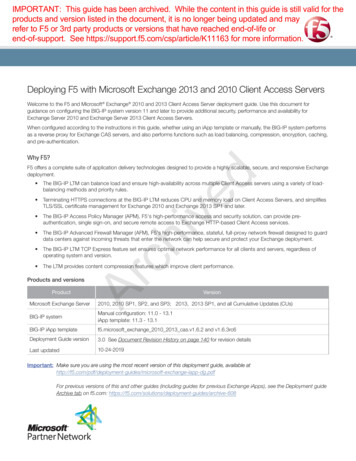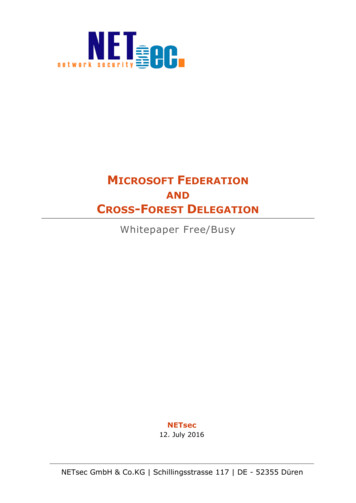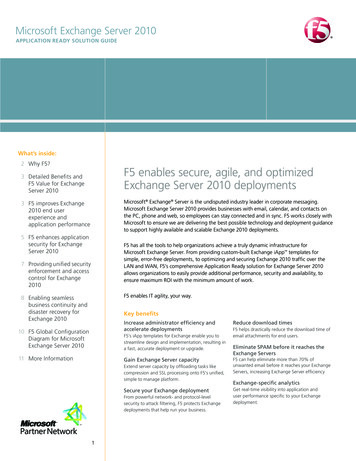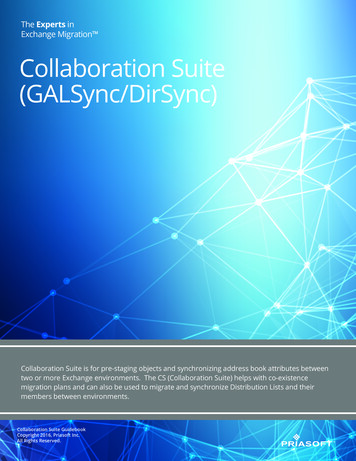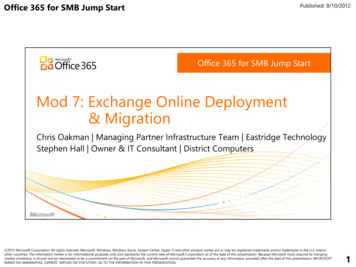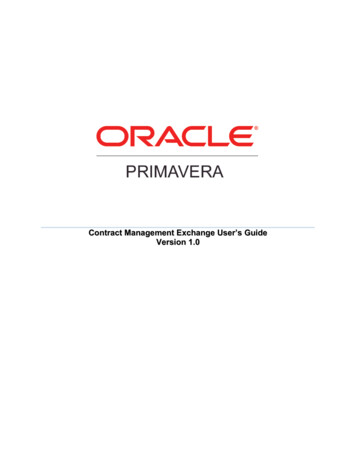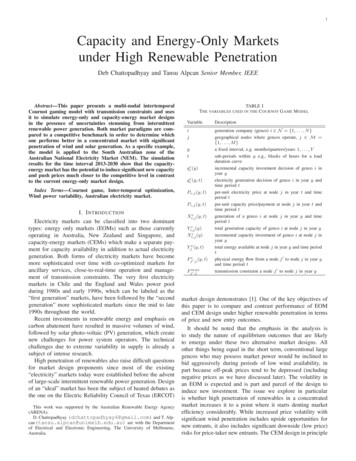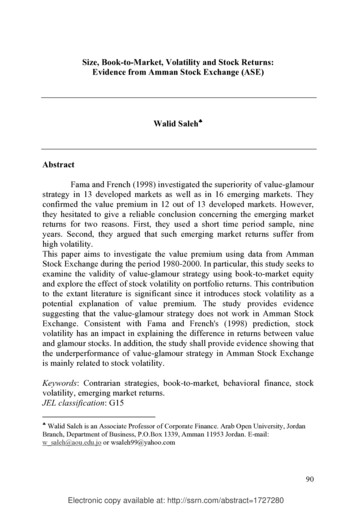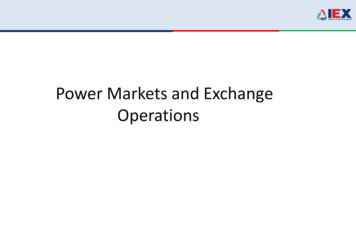
Transcription
Power Markets and ExchangeOperations
2Company Snapshot97% Market Share 5000 MW average daily trade6000 Participants4000 Industries 70 Commercial 50 Discoms400 Conventional Generators 1500 REParticipantsTransparencyLiquidityCompetition
3IEX Volume Growth : Strong trend line60,000Electricity Volume52,24150,000Cleared Volume (MU)46,21440,57640,00034,39729,270 160FY 09FY 10FY 11FY 12FY 13FY 14FY 15FY 16FY 17 FY18 FY 19Source: IEX Data (DAM TAM)FY 09: from 27 Jun’08-31 Mar’09; Actual Volume of FY 2018-19
DAM Cleared Volume v/s MCPCleared VolumeMCP60000850,13650000Cleared Volume (MUs)44,925639,831400005.19534,06628,925 28,1413.56 3.54 3.493.5122,330 2.8300003.863.262.732000011,801 7FY 15-16FY 14-15FY 13-14FY 12-13FY 11-12FY 10-11FY 09-100FY 08-090MCP (Rs/kWh)7.31
IEX Monthly Cleared Volume7000Total Monthly Volume (MUs)572560004965Cleared Volume 000 3066
Comparison: Market-wise Cleared Volume (MUs)(Apr-June)ProductQ1 FY18-19 Q1 FY19-20% 1441112,994-10%REC2,0091,196-40%ProductBuy BidSell BidCleared BidMCPQ1 FY18-19 Q1 9% Change-13%21%-14%-20%
Key statistics: Electricity & REC MarketELECTRICITYREC97.5%61%29 States I 5 UTs28 States I 5 UTsGenerators4871102IndustrialConsumers40733167 138,632 MWh 3 Crore RECsHighest: 32,39,142RECsMarket est : 208 ,423MWhIEX Data as on 21 MAY, 2019
TAM Monthly Snapshot -June’19TotalVolume(MWh)Max headContingency1,99,3607.003.85ContractsMin PriceWeeklyDaily
Increasing ParticipationMembers Clients5000Number of 3133003560 36523482341632103044 312128392887297537673315387240033421 35214130Open access consumers45754413 4463 4510434942543626 372839453816 3867 391246134632 4666 4686 469139904012 4024 4036 4090 4092
Open Access Status across Indian StatesEast & North EasternRegionNorthern DelhiUPGeneratorConsumer AssamBiharManipur/MizoTripura/SikkimGenerator ConsumerM.P DNH & DD GujaratChhattisgarhMaharashtra Jharkhand A.P. Meghalaya Orissa West Bengal Southern RegionWestern aka Allowed NotAllowedTamil NaduKerala Generator Consumer
Industrial segments with Textile29%Chemical9%Metal24%Manufacturer15%
Indian Electricity Markets
Markets
Market“Market is a mechanism for matching supply and demand for acommodity through the discovery of an equilibrium price”Requisites for Creation & Classification of MarketsQualityDate of DeliveryQuantityMode of SettlementPriceConditions to Contract
Exchange: A Competitive ‘Market’ Exchanges provide a transparent, competitive and efficient platform fortransactions in any market – Stock or commodity. Same is true for power sector. The concept of Exchanges in Power Sector was initially introduced in 1990-91 inEurope. Now, worldwide Power Exchanges are operating in almost 40 countries. Power Exchanges are most preferred option for sale and purchase of Power. In India, after Electricity Act, 2003 market framework for Exchange operationswas put in place. Exchanges in India started operations from 2008.
Power Exchange- Organized MarketplaceHandles Bidding Delivery Money RisksDelivery actsCentralCounterparty Spot Intra-Day Day-ahead Forward Weeks
Power Exchange CharacteristicsEasyAccessAutomated live trading systemAnonymousClosed bidding environmentDemutualised, with oversight committees set by regulator.TransparentEasy ed risk management, with regulatory oversight.Trade results made publicDisaster Recover siteReliableEstablished C&S, with no defaults till dateTerminals connected through MPLS and SSL only.SecureSurveillance room with necessary security (Separate network, Restrictedbiometric access, Video & Audio recording).Periodic IT system audit for data security, data integrity and operationalefficiency. Automated audit trail
Power Exchange facilitates Price Transparency– Ability to know the price of electricity in the market Risk Management– Manage price/ delivery risk– Secure and Regulated market Guaranteed performance of trades– Credit tracking mechanism– Default Mitigation mechanism Lower Transaction Cost Flexibility– Term of delivery– Time of Closure Access to a wider/ larger market spectrum
Power Exchange- OperationsSurveillance Function: Performed from a secure‘Surveillance Room’ withrestricted access Surveillance Committeereports to CERC quarterlyC&S Function: SeparateClearing &Delivery cells Risk Mgmt.Committeereports to CERChalf yearly Resultsdisplayed ontradingterminalsMarket results,including curvespublishedonlineMonthly reportto CERC
What benefits does the power exchange provide?Nation-widevoluntary accessDelivery BasedcontractsRobust PlatformE-tradingNo counterpartyrisk
Understanding exchange mechanismBidding mentof lossesand charges
Inside IEX Surveillance department of IEX is under continuous online CCTV monitoringand recording All Telephonic conversations are recorded with no out going facility The Heart of the exchange i.e. Surveillance room, is secured by limited andauthorized access and that too with Biometric sensor access All authorized persons of Surveillance room are not allowed to use anycommunicating medium (mobile phones) All process flow is documented in the form of check lists which is authorizedby HOD. Concurrent Audit of the checklist by internal auditors
Product SegmentsDay Ahead Market(DAM)Term AheadMarket (TAM)Renewable EnergyCertificates (RECs)Trade for the following dayContracts for every 15 min, closed auction Intraday Day Ahead Contingency Daily4 types of contracts WeeklyFrom 3 Hrs ahead to 11days in advanceTrade green attributes of electricity1 REC 1 MWh of green energy
Contract CharacteristicsTERM AHEAD MARKETContractCharacteristicDay AheadMarketIntradayContractsDay eryNext day0400-2400 Hrssame dayFor next dayFrom 2nd dayto next 8 daysFor next weekAuction TypeClosed stradingOpen AuctionContracts15 minHourlyHourlyBlock of Hours(Fixed)Block of Hours(Fixed)TradeAvailabilityAll DaysAll daysAll Days;All Days;Wed & ntPay-In- D-1; PayOut – D 1Pay in: T 1Pay in: T 1Pay out: T 1Pay out: T 2Pay-In- D-1; PayOut – D 1Pay-In- D-1; PayOut – D 1T TradeD Delivery
Erstwhile Vertically Integrated StructureGenerationVerticallyIntegrated StateElectricity rConsumer
Introducing CompetitionElectricity MarketProductionFunction GenerationTransportationFunction Transmission DistributionMerchantFunction Wholesaling (Supply) Retailing (Demand)Natural MonopoliesStep-1: Introduce competition in Supply side so as to decrease electricity prices.(Demand side competition doesn’t result in reduction of prices unlessproduction is competitive)Step-2: Introduce competition in Demand Side so as to pass the gains in supply sidedirectly to consumers
Pre requisites for a competitive marketUnbundling of Utilities Separation of Vertically integrated utilities, transmission should be separated fromgeneration & supplyMulti Buyer Model Choice to consumers to buy from any generator or third party Choice to generator to sell to any buyerSystem operator Independent System Operator:To maintain grid security and reliability, transmission allocationOpen AccessImbalance SettlementMechanism Open Access in Transmission & Distribution Network Deviation or Imbalance settlement mechanism to ensure discipline Balance Responsible Party ( Control Areas)Trading Recognizing trading as a distinct activityAutonomous Regulator To overlook the working of the Market
Development of Power MarketAdvantages of an Organized Power Market Market Participants can efficiently manage their portfolios by choosing differentproducts available under long term , medium term and short term duration. Provides an exit route for PPAs. Efficient Market provides transparency and which may lead to easy financing . Markets are driven by the force of economies i.e. demand and supply and hence theprices are derived. Market Participants e.g. DISCOMS may reap benefits of real time balancing. Typically lower unit pricing compared to standard electricity supply contracts. Derivative products may provide an avenue to hedge against spot-price volatility28
Regulatory Boost for Power Market Development (1/2) EA 2003 and enabling provisions on Power MarketThe intent and object of the EA 2003 is to develop power market throughincreased competition, more players and protect consumer interests Development of Power Market – EA 2003, Section 66, “The AppropriateCommission shall endeavor to promote the development of powermarket ”, guided by the National Electricity Policy Suitable safeguards to prevent adverse effect on competition Recognized Trading as a distinct activity. Defined under section(2) (47):“Purchase of electricity for resale thereof” Adequate and progressive provisions governing open access both:» to transmission networks (inter-state and intra-state) and» to distribution networks29
Regulatory Boost for Power Market Development (2/2) National Electricity Policy 2005 – Para 5.7“ To promote market development, 15% of the new generating capacities, be soldoutside long term PPAs”.-As the power markets develop, it would be feasible to finance projects withcompetitive generation costs outside the long term PPAs .this will increase thedepth of power markets .and in long run would lead to reduction in tariff” Open Access Regulations , 2004 & 2008 Universal Open Access to transmission networks Separate procedures for ‘Day-Ahead Market( collective transactions) and OTCtransactions30
Evolution of Electricity RegulationsThe Indian Electricity Act, 1910The Electricity (Supply) Act, 1948Electricity Laws (Amendment Act), 1991Electricity Laws (Amendment Act), 1998And Electricity Regulatory Commissions Act, 1998The Electricity Act, 2003(Consolidates above laws)Open Access Regulations, 2004Power Exchange Guidelines, 2008Power Market Regulation, 2010MoL Notice of Open Access Circular , Nov,2011The Electricity Act Amendment Bill , 2014
Market related legislations in IndiaElectricity Act, 2003 De-licensing of generation Development of a multi-buyer multi-seller market in power Trading – licensed activity.National Electricity Policy,2005 Sec 5.7.1 (f) Enabling Regulations for inter and intra state trading and alsoregulations on power exchange shall be notified by the appropriatecommission within six monthsNational Tariff Policy, 2006 Promote Merit Order Competitive Bidding compulsory Cross Subsidy Surcharge formula
Legislative Enabler for operationalization of Power Marketsin India : Electricity Act 2003 Intent of the Act was to promote competition by “freeing” all possibleavenues of procurement and sale of power: De-licensing of generation (Sec-7) Development of a multi-buyer multi-seller market in power (Restructuringof SEBs – Sec 131) Trading – licensed activity (Sec-12). Non Discriminatory open access to transmission (Sec 38-40) and OpenAccess in Distribution (Sec-42) Autonomous Regulatory Commission (Sec 76) to overlook functioningof Power markets Development of Power Market Section 66 of the Electricity Act 2003 gives powers to the regulatorycommissions to develop the power market including trading
Framework for Development of Power MarketLegislative and Regulatory Framework Electricity Act, 2003Open Access means “The non discriminatory provision for the use oftransmission lines or distribution system by any licensee or consumer or aperson engaged in generation in accordance with the regulations specifiedby the appropriate commission” Open Access to transmission network was introduced after theElectricity Act,2003– Open Access to inter-state transmission immediately allowed by theCentre CERC (Interstate Open Access) Regulation, 2008– Facilitates bilateral transactions– Non – discriminatory use of transmission lines– Nominated SLDC/RLDC to carry out transactions
Evolution of Power Markets in India:Regulatory Framework2004: First CERC OA Regulations Reservation of transmission capacity: Long Term and Short Term Access Short term open access granted on inherent margins2005: Trading License Regulations2008 & 2009: CERC OA Regulations and Amendments Defined ‘Power Exchanges’ Transaction categorized as Bilateral or Collective (thru PXs) Transmission charges: ‘PoC’ Method for collective transactio
Features of Power Market Regulations, 2010Role of PXs defined and norms for setting up and operating PX Procedure for application, eligibility criteria, shareholding pattern, Net worth, riskmanagement by PX,CERC approval for setting up a PX and oversight for contracts offeredObjectives for PX Ensure fair, neutral, efficient and robust price discovery Provide extensive and quick price dissemination Design standardised contracts and work towards increasing liquidity in contractsDefined principle of price discovery for the exchange Economic principle of social welfare maximisation Closed double sided bidding, uniform price discovery, market splitting for congestionmanagement
Open Access in Inter-State Transmission Regulation Implemented w.e.f. 6-May-2004, revised Regulations w.e.f 1st April 2008and amended in May 2009. Transmission Capacity Reservation Categories Monthly bilateral Advance /FCFS Day ahead bilateral Collective Transactions through Power Exchange Intra day bilateral Nodal Agency Bilateral : RLDCs & Collective : NLDC Transmission Charges moved from “Contract Path” to “Point of Connection” forCollective/Bilateral Other Commercial Issues Handing deviations from schedule Handing reactive energy supply/drawl Payment security Collection and disbursement of charges
Power Procurement optionsProcurementContractsProsConsLong Term Escape volatility of short term and spotmarketsMeets base load requirementsTransmission availability Capacity EnergyFalling short term prices may make costlycontracts obsolete and sunk Escape volatility of short term and spotmarketsMeets intermediary load requirements,help escape long term commitment forsuch requirementsTransmission availability after LTOnly to meet fixed seasonal orintermediary load requirementsBilateral No long term commitmentFlexible response to demandPriority over PX, unless Spot Costlier than PX SpotCongestionRegulatory risksPX Spot No long term commitmentPrice transparencyFlexible response to demand VolatileCongestionRegulatory risks Realtime load balance VolatilityPenalties Medium TermShortTermUI/DSM
Indian Power Market Development Improved liquidity and EfficiencySpot tradingon Exchanges
Open Access Status across Indian StatesNorthern DelhiUPGeneratorEast & North Eastern RegionConsumer States eghalayaOrissaWestern RegionStatesGeneratorWest Bengal DNH & DD GujaratChhattisgarhMaharashtra Consumer Southern RegionConsumerM.PGeneratorStatesA.PKarnataka Allowed Not AllowedTamil NaduKeralaGeneratorConsumer
Open Access: What a consumer paysChargesPoC charges Inter-State Transmission charges payable by the open access consumerTransmission Charges or STU Charges Payable to the state transmission utility for the use of the transmission system for availing powerthrough open access.Wheeling charges Charge to the Discom for conveyance of electricity through open access as determined by the SERCsCross Subsidy Surcharge Subsidising open access consumer has to pay a cross subsidy surcharge to the Discom.Others Additional Charges, if any NLDC application fee, scheduling and operating charges, SLDC Charges IEX transaction charges/Trading Margin
Open Access: What a consumer paysLosses An open access consumer has to bear in kind the following losses as defined by therelevant regulationsPoint of connection (PoC) loss Inter-State transmission system lossTransmission loss or state loss Consumer to absorb apportioned energy losses in thetransmission system as per the relevant regulationsWheeling loss Technical losses in the distribution system determined atvarious voltage level by the state commissions.
Further in this presentation Overview of Power ExchangeIntroduction toPower ExchangesPower ExchangeOperations Surveillance Delivery and Scheduling Clearing and Settlement
Introduction to Power Exchange
IEX - India’s Premier Power Exchange0106Fast Growing Sector & ConduciveGovernment Policies02Robust andScalable Technology05Rapidly GrowingTrade Volumes(1) For 11 months FY17 (2) Participants are located across 29 states and 5 UTs alsoIndia’s first & largestpower exchange03 Efficient Price Discoveryand Flexibility04Diverse Participant BaseEnsuring liquidity
Intra DayRECProduct Portfolio
Who Can become Members of IEX ?Entities eligible for Membership: Inter-State Generating Stations (ISGS) Distribution Licensees State Generating Stations IPPs CPPs and IPPs(with consent from SLDC) Open Access Customers(with consent from SLDC) Electricity Traders / Brokers
Product SegmentsDay Ahead Market(DAM)Term AheadMarket (TAM)Renewable EnergyCertificates (RECs)Trade for the following dayContracts for every 15 min, closed auction Intraday Day Ahead Contingency Daily4 types of contracts WeeklyFrom 3 Hrs ahead to 11days in advanceTrade green attributes of electricity1 REC 1 MWh of green energy
Contract CharacteristicsTERM AHEAD MARKETContractCharacteristicDay AheadMarketIntradayContractsDay eryNext day0400-2400 Hrssame dayFor next dayFrom 2nd dayto next 8 daysFor next weekAuction TypeClosed stradingOpen AuctionContracts15 minHourlyHourlyBlock of Hours(Fixed)Block of Hours(Fixed)TradeAvailabilityAll DaysAll daysAll Days;All Days;Wed & ntPay-In- D-1; PayOut – D 1Pay in: T 1Pay in: T 1Pay out: T 1Pay out: T 2Pay-In- D-1; PayOut – D 1Pay-In- D-1; PayOut – D 1T TradeD Delivery
IEX Membership yTradersRight to trade andclear on its ownaccountTrade and clearon behalf of itsClientsTrade and clearon behalf of itsClientsGeneratorDistributionlicensees- IPPs CPP- MPPs –O AconsumersNO CREDIT/FINANCINGCREDIT/FINANCINGClientsGrid ConnectedGenerator, Distribution licensees, IPPs, CPP, MPP, OAconsumersTrader ClientWith valid PPA
Financial RequirementsMembership Category: Proprietary / Professional Member Thefinancial criteria for payment options available on IEX are:FeesProfessional & Proprietary &Electricity Trader(Full Payment Option)Proprietary member(Light Payment Option)Admission feeRs. 35,00,000Rs. 10,00,000Interest Free SecurityDepositRs. 25,00,000Rs. 10,00,000Annual SubscriptionFeesRs. 5,00,000Rs. 2,50,000Processing FeesRs. 10,000Rs. 10,000TOTALRs. 65,10,000Rs. 22,60,000Exchange Transaction2p/kWh3p/kWh
How to Move Ahead Become Member or Client (of a Member) options Rs 22.6 Lacs 3p/kWh transaction fee Rs 65.1 lacs 2p/kWh transaction fee Client @ 1LakhTechnical Requirements Standing Clearance from UTs/State SLDC ABT Meters Sufficient transmission capacityConnectivity with exchange can be done in two ways Internet Immediate Leased LineStart Buying from IEX or Sell surpluses to IEX
RegistrationPRE -TRADINGSELECTION OF MEMBER1 weekMember Related ActivitiesExchange Related ActivitiesMETERING (unless already done)0.5-3 Special Energy MeterMonthsSLDC Clearance/NOC NOC from respective SLDC1 MonthRegistration at IEX Client registration for each point of drawal Unique id created in Exchange system0.15Month
Exchange OperationsDAM & TAM
Exchange Operations Covers - Surveillance Delivery and Scheduling Clearing and Settlement
Surveillance
Features of Day Ahead MarketClosed double-sided anonymous auction for each 15min time block for the following dayIntersection between the aggregated sale and purchasecurves defines the market clearing price (MCP)13 Bid area definedCongestion Management through market splitting anddetermining Area Clearing Price (ACP) specific to anareaBid types: Portfolio Orders or Block OrdersMinimum bid Re.1 for 0.1MWhMinimum Price & Volume Step 0.1p * 0.1 MWh13 Bid Areas
Model Price Calculation algorithmPrice Tick (Rs.)011.122.12.533.144.15----------20Portfolio A, MWPortfolio B, MWPortfolio C, 0Total Buy Quantum received, MWTotal Sell Quantum received, -120-120-120-120-120-120-12012010080300-100-100Bid Quantumby differentportfoliosPriceNet Transaction, MWDemand(Buy)80-20-31-80Supply(Sell)Market clearingprice (MCP) 2.560VolumeMarket Clearing Volume (MCV)MW-100-100-100-100
Day Ahead Market-Collective Transaction Trading processBiddingMatchingReview corridor andfunds availability10:00 am to12:00 pm12:00 pm to1:00 pm1:00 pm to2:00 pmBids for 15min eachor blockbids can beplacedMCP&MCVcalculatedCorridoravailabilityand fundsverifiedResultConfirmationScheduling3:00 pm5:30 pm6:00 pmFinal ACV andACPcalculated.Marketsplitting ifcongestionCollectivetransactionconfirmationby NLDCFinal Schedulesent to RLDCforincorporation
Trade,Scheduling and Clearing ProcessNOC submission to Delivery Dept.MemberSchedulingSurveillance check forBidding as per NOCPIPO & ObligationReportsSurveillance check forBidding as per NOCFinal ResultMatchingProvisional Result
Day Ahead Market-Collective TransactionBid Types Bids for each 15 mincan be entered Varying price andquantum pairs Allow partial executionSingle Bid All or None Type Fixed Price andQuantity Pair No partial executionBlock Bid
Understanding of Single BidBuy Bid: One or more quantity-pricepairs, each specifying the maximumprice at which the participant iswilling to buy the correspondingquantity of electricity and areSellBid: One independentlyor more quantity-pricesubmittedfor eachpairs,eachspecifyingtheminimumdelivery period i.e. 15 min block.price at which the participant is willingto sell the corresponding quantity ofelectricity and are submittedindependently for each delivery periodi.e. 15 min block.SelectionSelection Criteria:Criteria:SellBuy Bid-BidsBid-Bids specifyingspecifying aa priceprice notnot higherlowerthanthan thethe ClearingClearing PricePrice areare acceptedacceptedAcceptedAccepted BidsBids areare valuedvalued atat Market/AreaMarket/AreaClearingClearing Price.Price.HenceHence SellerBuyer SurplusSurplus isis theDifferenceDifference betweenbetween thethe submittedsubmitted priceprice andandthethe marketmarket price,price, multipliedmultiplied byby thethe quantityquantityactuallyactually sold.purchased.Block No.FullSelectionPartial SelectionRejection00:00-00:1500:45-01:00If CP 3000CP 6000If 2999 CP 30006000 CP 6001If CP 2999CP 600100:15-00:3001:00-01:15i) For 200 MW;CP 3000CP 4000ii) For 100 MW;i) Between 200 &100 MW3000 CP 40003999 CP 30013001 CP 40003000 CP 3999ii) Between 100 & 0 MW4000 CP 40012999 CP 3000i) For 200 MW;CP 3001CP 3999ii) For 100 MW;CP 4001CP 2999If CP 6000CP 3000If 5999 CP 60003000 CP 3001If CP 5999CP 300100:30-00:4501:15-01:30
Understanding of Block BidA block bid is used for the procurement or sale of power which is specific to a block of hours (e.g. baseload, peak or user defined). A block bid can either be a buy order or a sale order for a block of hours.Either all hours of the block order are jointly successful or all of these block hours are jointly rejected. Ablock bid is selected if the bid price is better than the average system price of power in respective blockhours.Example of Sell Block Bid:-System Price:-Selection Criteria:- A sell (respectively buy) bid is said to be selected if the submission price of the bid isbelow (respectively above) the average system price.Result for 1st Block BidE5 at 5000 for 50 MW Sell is at below price than Average Price of Rs. 5875.90; hence will be selected.Result for 2nd Block BidE6 at 7000 for 50 MW Sell is at above price than Average Price of Rs. 5875.90; hence will be rejected.
Illustration of Price Matching andMarket Splitting Two regions have been considered i.e. ER and SR. Four Sellers and Two Buyers in a 15-Min Block are taken with following Bid Scenario: -200 MW @2000100 MW@3000100 MW @3000ER REGION100 MW@4000SR REGION100 MW @3000300 MW @4000Quantity (MW)Price (Rs./MWhr)ER Seller-12002000ER Seller-21003000SR Seller-11003000SR Seller-21004000SR Buyer3004000ER Buyer1003000
Understanding Price MatchingER Seller-1200 MW@2000/MWhrER Seller-2100 MW@3000/MWhrSR Seller-1100 MW@3000/MWhr3005Total Buy (MW)TotalBuyerSell (MW)SR Seller-2SR3004100 MW@300 MW@Demand-Supply30034000/MWhr intersection4000/MWhrwithER Buyer100 MW@3000/MWhr3002high 000)(200,2000)(200,2000)(200,2000)(200,2000)Market Clearing Price (MCP) Rs. 3000/MWhrMarket Clearing Volume(MCV) 400 MW
Price3000Buy Quantity400.00Sell Quantity400.00
REQUIREMENT OF CORRIDOR FROM NLDCERSRNet Demand 100Net Demand 300Net Required Flow- 200 MWNet Supply 300Net Supply 100Net 100 – 300 -200Net 300-100 200Demand and Supply gap in two regions get balanced by unconstrained flow between the tworegions hence a common MCP is derived.200 MW @2100 MW@3ER REGION (PRICE 3/unit)100 MW @3100 MW @3Required Flow 200 MW0 MW@4SR REGION (PRICE 3/unit)300 MW @4
Constraint Solution (Market Splitting)Congestion was reported by NLDC from ER to SR corridor and flow is constrained to 100MW. Due toflow constraint, system will “Split” the market in to two regions i.e. Deficit (SR Region) and Surplusregion (ER Region),and will again run the calculation chronology for both the regions separatelyconsidering the flow constraint and will derive the ACP and 00ER Buyer10010010010010010010000000000Net -300-300-300-3006000-1008000-100Price (Rs./kWh)ER-Surplus ER Seller-1Region ER Seller-2Flow Towards SR of 100 0SR Buyer30030030030030030030030030030000000Net 00-200-200Price (Rs./kWh)SR-Deficit SR Seller-1Region SR Seller-210000 20000-100-100
Final Results after Market SplittingACP Surplus Region (ER)2499.50 (Rs/MWh)ACP Deficit Region (SR)4000.00 (Rs/MWh)Status of Buyers and SellersQuantity (MW)Price (Rs./MWhr)SelectionER Seller-12002000YesER Seller-21003000No (Status changed)SR Seller-11003000YesSR Seller-21004000YesSR Buyer3004000Yes (Status changed)ER Buyer1003000Yes
ER Surplus RegionDemand-Supply CurveSR Deficit RegionDemand-Supply Curve
Term-Ahead MarketPrice Discovery and Biddingwww.iexindia.com
TAM Market SegmentsOpen AuctionContinuousContinuousContinuous72
Types of Contracts Weekly and Daily––––FBAFNTFDYFPK-- Firm Base – 24 Hrs-- Firm Night – 8 Hrs (0-7 & 23-24)-- Firm Day – 11Hrs (7-18)-- Firm Peak – 5 Hrs (18-23) Day Ahead Contingency and Intra-Day–Hourly ( DAC-24 hrs & Intraday-04-24)Region Specific Contracts73
Trading of Intra-day ContractsTrading HourTrading Hours:19.5(00:30-20:00)0:30-11-22-33-44-5 5-66-7 7-8 1619-20DeliveryHours:20(04-24)4-55-66-7 7-8 8-9 9-10 10-1120-2111-12 12-13 13-14 14-15 15-16 16-17 17-18 18-19 19-2021-22 22-23 23-2474Contracts available for delivery on the same day
Intra-day & DAC contracts with current trading systemTrading DateTrading TimeIntra-Day contractsTrading TimeDAC contracts15:00-21:3015:00-22:3015:00-23:00H1 to 24 (of 18-04)17-04-201600:30 - 01:30H5 to 24 (of 17-04)17-04-201600:30- 02:30H6 to 24 (of 17-04)17-04-201600:30- 03:30H7 to 24 (of 17-04)17-04-201600:30- 04:30H8 to 24 (of 17-04)17-04-201600:30- 05:30H9 to 24 (of 17-04)17-04-201600:30- 06:30H10 to 24 (of 17-04)17-04-201600:30- 07:30H11 to 24 (of 17-04)17-04-201600:30- 08:30H12 to 24 (of 17-04)17-04-201600:30- 09:30H13 to 24 (of 17-04)17-04-201600:30- 10:30H14 to 24 (of 17-04)17-04-201600:30- 11:30H15 to 24 (of 17-04)17-04-201600:30- 12:30H16 to 24 (of 17-04)17-04-201600:30- 13:30H17 to 24 (of 17-04)17-04-201600:30- 14:30H18 to 24 (of 17-04)17-04-201600:30- 15:30H19 to 24 (of 17-04)17-04-201600:30- 16:30H20 to 24 (of 17-04)17-04-201600:30- 17:30H21 to 24 (of 17-04)17-04-201600:30- 18:30H22 to 24 (of 17-04)17-04-201600:30- 19:30H23 to 24 (of 17-04)17-04-201600:30- 20:30H24 to 24 (of 17-04)H2 to 24 (of 18-04)H3 to 24 (of 18-04)
Trading of Weekly & Daily Contracts Daily ContractsT 2 to T 9 Weekly Contracts-Tradingon every Wednesday andThursday for Delivery FromMonday to Sunday.76
Term Ahead Market-Bilateral Transactio
Day Ahead Market Next day Closed Auction 15 min All Days Pay-In- D-1; Pay Out -D 1 Intraday Contracts 0400-2400 Hrs same day Continuous trading Hourly All days Pay in: T 1 Pay out: T 1 Day Ahead Contingency For next day Continuous trading Hourly All Days; 1500-2300 Pay in: T 1 Pay out: T 2 Daily Contracts From 2nd day to next 8 days .



